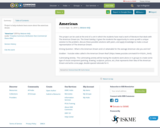
Project to help students learn more about the american dream
- Subject:
- English Language Arts
- Material Type:
- Activity/Lab
- Date Added:
- 06/24/2019

Project to help students learn more about the american dream

This class examines how and why twentieth-century Americans came to define the “good life” through consumption, leisure, and material abundance. We will explore how such things as department stores, nationally advertised brand-name goods, mass-produced cars, and suburbs transformed the American economy, society, and politics. The course is organized both thematically and chronologically. Each period deals with a new development in the history of consumer culture. Throughout we explore both celebrations and critiques of mass consumption and abundance.
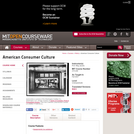
This class examines how and why twentieth-century Americans came to define the “good life” through consumption, leisure, and material abundance. We will explore how such things as department stores, nationally advertised brand-name goods, mass-produced cars, and suburbs transformed the American economy, society, and politics. The course is organized both thematically and chronologically. Each period deals with a new development in the history of consumer culture. Throughout we explore both celebrations and critiques of mass consumption and abundance.
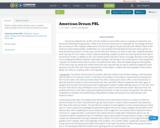
Project to help students develop a more complete understanding of what the American Dream is to them.
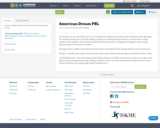
Project to help students learn more about the american dream

This course explores the experiences and understandings of class among Americans positioned at different points along the U.S. social spectrum. It considers a variety of classic frameworks for analyzing social class and uses memoirs, novels, and ethnographies to gain a sense of how class is experienced in daily life and how it intersects with other forms of social difference such as race and gender.
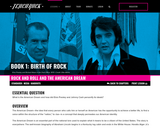
In this lesson, students will explore the persistence of the American Dream by juxtaposing the writings of Horatio Alger Jr. and John Steinbeck with the artistic output of Elvis and Cash. If the American Dream as an ideology has always been a balance between myth and reality, these artists, and Rock and Roll culture more generally, gave the myth something real. Through a survey of literature, album art, songs, television news reports, film, and other materials, students will examine how these artists became symbols of the American Dream for their many fans.

The 11th grade learning experience consists of 7 mostly month-long units aligned to the Common Core State Standards, with available course material for teachers and students easily accessible online. Over the course of the year there is a steady progression in text complexity levels, sophistication of writing tasks, speaking and listening activities, and increased opportunities for independent and collaborative work. Rubrics and student models accompany many writing assignments.Throughout the 11th grade year, in addition to the Common Read texts that the whole class reads together, students each select an Independent Reading book and engage with peers in group Book Talks. Students move from learning the class rituals and routines and genre features of argument writing in Unit 11.1 to learning about narrative and informational genres in Unit 11.2: The American Short Story. Teacher resources provide additional materials to support each unit.

In this unit, students will take a look at the historical vision of the American Dream as put together by our Founding Fathers. They will be asked: How, if at all, has this dream changed? Is this dream your dream? First students will participate in an American Dream Convention, acting as a particular historical figure arguing for his or her vision of the American Dream, and then they will write an argument laying out and defending their personal view of what the American Dream should be.
ACCOMPLISHMENTS
Students read and annotate closely one of the documents that they feel expresses the American Dream.
Students participate in an American Dream Convention, acting as a particular historical figure arguing his or her vision of the American Dream.
Students write a paper, taking into consideration the different points of view in the documents read, answering the question “What is the American Dream now?”
Students write their own argument describing and defending their vision of what the American Dream should be.
GUIDING QUESTIONS
These questions are a guide to stimulate thinking, discussion, and writing on the themes and ideas in the unit. For complete and thoughtful answers and for meaningful discussions, students must use evidence based on careful reading of the texts.
What has been the historical vision of the American Dream?
What should the American Dream be? (What should we as individuals and as a nation aspire to?)
How would women, former slaves, and other disenfranchised groups living during the time these documents were written respond to them?
BENCHMARK ASSESSMENT: Cold Read
During this unit, on a day of your choosing, we recommend you administer a Cold Read to assess students’ reading comprehension. For this assessment, students read a text they have never seen before and then respond to multiple-choice and constructed-response questions. The assessment is not included in this course materials.

In this lesson, students will hear the final presentations, evaluate the arguments, and vote on the most convincing visions presented.

In this lesson, students will get into character and introduce themselves to the others who will be at the convention.
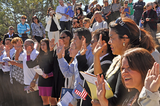
In this lesson, students will meet with their Independent Reading group to discuss their book and how it relates to the conversations they have been having about the American Dream.
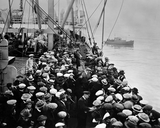
In this lesson, you will begin to think about the idea of the American Dream, and you'll learn about the project and requirements for this unit.In this lesson, students will begin to think about the idea of the American Dream, and they'll learn about the project and requirements for this unit.

In this lesson, students will meet with their Independent Reading Group to discuss the reading so far.

In this unit, students will explore great works of American literature and consider how writers reflect the time period in which they write. They will write two literary analysis papers and also work in groups to research and develop anthologies of excellent American stories.
ACCOMPLISHMENTS
Students read and analyze stories from several 19th-, 20th-, and 21st-century American authors. After researching a time period, they select stories from that period to create an anthology. The readings enhance their understanding of the short story, increase their exposure to well-known American authors, and allow them to examine the influence of social, cultural, and political context.
Students examine elements of short stories and have an opportunity for close reading of several American short stories. During these close readings, they examine the ways that short story writers attempt to explore the greater truths of the American experience through their literature.
GUIDING QUESTIONS
These questions are a guide to stimulate thinking, discussion, and writing on the themes and ideas in the unit. For complete and thoughtful answers and for meaningful discussions, students must use evidence based on careful reading of the texts.
If you were to write a short story about this decade, what issues might you focus on?
What defines a short story? Just length?
To what extent do these stories reflect the era or decade in which they were written?
To what extent are the themes they address universal?
CLASSROOM FILMS
History.com has short videos on the Vietnam War (“Vietnam” and “A Soldier's Story”).
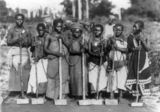
In this lesson, students will have time to continue working on their short essays with support from you and their peers.

In this lesson, students will revisit the American Dream in Unit 1. In pairs, they will find images and slogans to use as the basis for a collage that represents their view of the American Dream.
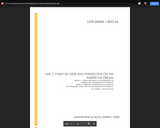
In the first bend of this unit, students will closely read multiple perspectives on the “American Dream” in
order to collect information to use and integrate that information into an evidence-based perspective.
Students will examine primary and secondary source documents to make informed decisions about
what information to collect that may inspire their writing about “The American Dream.”
In the second bend of this unit, students will engage in a short-research process to create a draft of
argumentative speech on the “American Dream” with a specific purpose, audience, and tone in mind.
They will use their inquiry research questions from bend one to begin analyzing search results and citing
and gathering relevant, accurate, and credible information.
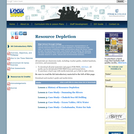
This kit covers a historical overview of American representations of natural resources from ancient Indian basketry to contemporary web sites. It compares conflicting media constructions about the Exxon Valdez oil spill, the damning of rivers, and Chukchi sea oil drilling. By showing the slow realization that natural resources are finite, students will learn valuable lessons in earth, natural and environmental sciences.